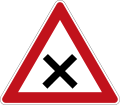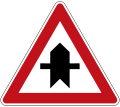Priority to the right
Priority to the right is a right-of-way system, in which a driver of a vehicle is required to give way to vehicles approaching from the right at intersections. The system is stipulated in Article 18.4.a of the Vienna Convention on Road Traffic for countries where traffic keeps to the right and applies to all intersections where it is not overridden by priority signs (uncontrolled intersections), including side roads and roundabouts (but not paths or earth-tracks).
Usage
The system is widely used in countries with right-hand traffic, including most European countries.
What varies, however, is the prevalence of uncontrolled intersections. In some countries, virtually all roads are controlled with priority signs or traffic lights, while others, such as France, even apply the system on intersections with heavy traffic such as the Place de l'Étoile around the Arc de Triomphe and the Paris Ring Road.
Most states in the United States enforce priority to the right in uncontrolled intersections where motorists must yield to the right,[1] although these intersections are less common. Increasingly, municipalities across the US have introduced all way stops, traffic signals and other designations such as multiple lane right-of-way or paved vs. unpaved roads as a means of controlling the intersections to decrease the likelihood of a collision and to make it easier to determine liability in the event of an accident.[1] At T-Intersections, traffic on the terminating road must yield to all traffic at the termination point.
Some countries use the priority-to-the-right rule, despite driving on the left. Australia uses the priority to the right rule on four-way intersections where the roads all have equal priority, but specific rules apply for T-intersections.[2] Most intersections are marked and signed however, so this rule is mostly applied at intersections with failed traffic lights.Singapore also uses priority to the right, as well as priority to vehicles going straight and turning vehicles to give way to vehicles going straight.
Signage
Intersections to which priority to the right applies are usually not equipped with signage or road markings. Priority signs override the priority to the right rule and are often used on roads with heavier traffic. However, if an intersection is not easily visible, a warning sign (usually a white or yellow triangle with red border and a cross symbol) may be erected. This sign does not regulate priority but just warns of an intersection. White, yellow and black diamond signs on the main road show that users have priority over entering traffic.
Under the priority-to-the-right system, priority is always given to traffic entering an intersection from the right, unless priority signage overrules this.
In Switzerland, road markings may also be used to indicate that the junction is a priority-to-the-right junction.
 Dangerous uncontrolled intersection ahead. This is not a priority sign, but a warning sign. It is only used at intersections where priority to the right applies.
Dangerous uncontrolled intersection ahead. This is not a priority sign, but a warning sign. It is only used at intersections where priority to the right applies. Dangerous intersection with priority indication (for the next intersection only). Different variants of the sign can be used on both priority- and non-priority roads. {Each sign has the thicker line indicating the road or direction that has priority with the viewer's own direction being from the bottom of the sign.}
Dangerous intersection with priority indication (for the next intersection only). Different variants of the sign can be used on both priority- and non-priority roads. {Each sign has the thicker line indicating the road or direction that has priority with the viewer's own direction being from the bottom of the sign.}
 End of priority road (priority to the right applies at uncontrolled intersections)
End of priority road (priority to the right applies at uncontrolled intersections) Additional sign of a shape of the intersection and a definition of the priority
Additional sign of a shape of the intersection and a definition of the priority
See also
References
- 1 2 "Texas Driver's Handbook" (PDF). July 2012. Retrieved 2013-08-08.
- ↑ National Road Transport Commission (2012-02-05). "Rule 72, 73". Australian Road Rules (PDF). ISBN 0-7240-8874-1.